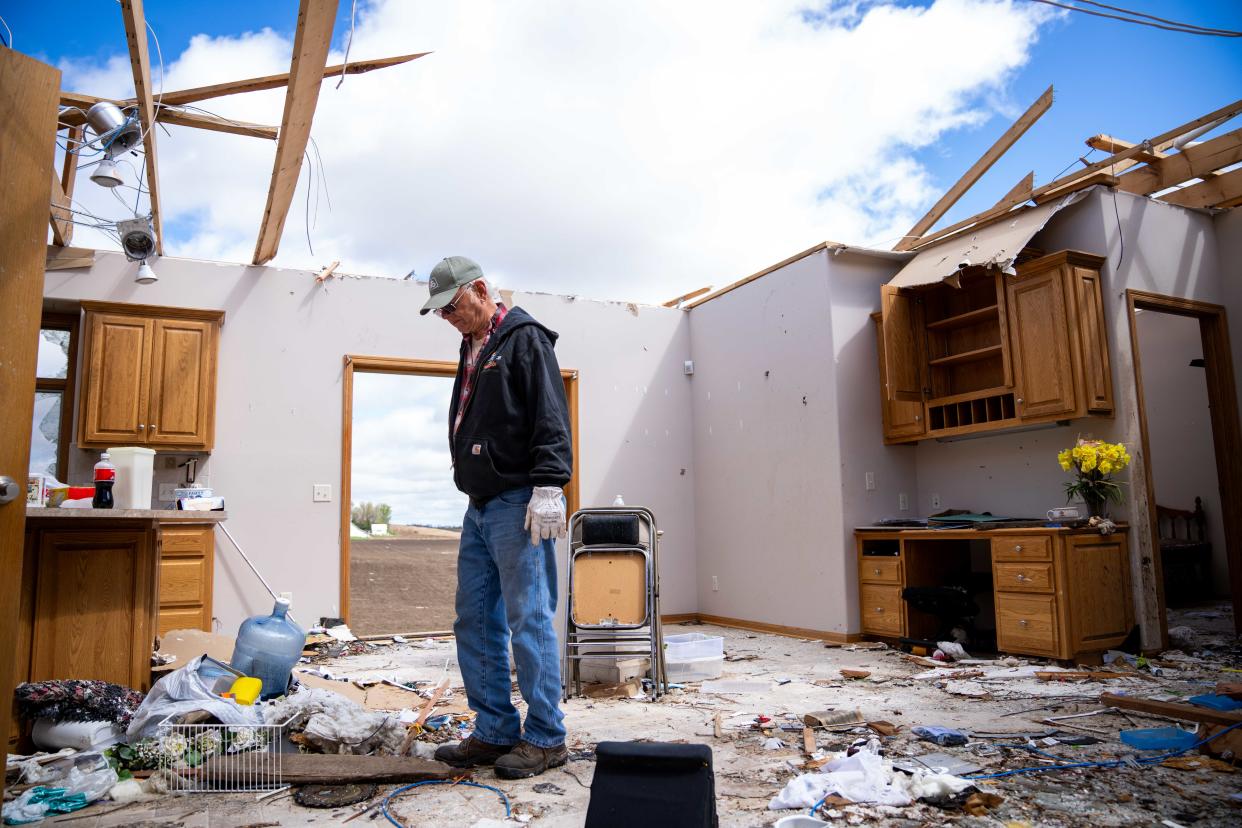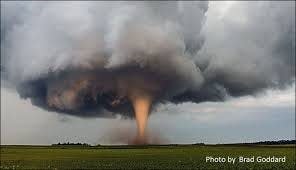Iowa town has been hit twice by major tornadoes. Is it a magnet for the storms?
The storm Friday that struck the tiny southwest Iowa town of Minden, destroying dozens of structures and fatally injuring one resident, wasn’t the community’s first experience with a devastating tornado.
An EF4 tornado, even stronger than Friday's EF3, hit the town on June 26, 1976, causing $13.7 million in property damage, as measured in today’s dollars. There were no deaths, despite close calls for dozens of residents who had been attending a carnival when the twister touched down, sending them fleeing for shelter to buildings that failed to withstand the winds.
It's far from the only U.S. city to have had more than one brush with a devastating tornado. The best known is probably Moore, Oklahoma, an Oklahoma City suburb. In the 122 years from 1893 to 2015, it was hit 26 times by tornadoes that included two top-of-the-scale EF5 storms. One in 1999 killed 36 people and injured nearly 600 and another in 2013 killed 24 and injured more than 200.

Iowa also has examples, including a metro Des Moines city hit during Friday's storms. Pleasant Hill, where an EF2 tornado damaged a number of houses, also suffered tornado strikes in 1974, 1982 and 2022.
MAP: See every tornado in Iowa since 1950
What determines where a tornado touches down?
Could it be that some places in the traditional Midwestern Tornado Alley are natural tornado magnets?
There has been speculation over the years citing factors like topography and temperatures. And of course there are explanations with religious roots, both biblical and in Native American lore.
But according to William Gallus, a professor of meteorology at Iowa State University who is a nationally recognized expert on tornadoes, the best science can conclude is that it really just comes down to coincidence.

“The scientific view on that is there's really no geography big enough, significant enough in much of the central U.S., including Iowa, to influence tornadoes,” Gallus said.
That leaves random chance. It you were to blindfold a person, spin them around until they're dizzy and then have them make a mark on a map with a pen, then do it again and again and again, for years on end, “What you are going to see is just from the randomness ... there will be places that might get hit two or three times in ... 50 years and many areas that won’t get hit at all," Gallus said. "We do not believe there’s anything that can explain it.”
“It’s just kind of bad luck that Minden has been hit twice,” he added.
Are some places just safer than others?
On the other side of the equation, is it possible, as some people hold, that some areas can be immune from tornadoes because they're in a valley or near a river?
Gallus pointed out tornadoes form out of thunderstorms, which can happen anywhere.
“A thunderstorm cloud is maybe 10 miles tall and 10 miles or more across, so it’s a very big thing, and I say a tornado laughs at your valley or river theory,” he said.
Gallus said tornadoes have been documented to cross the Continental Divide, go up or down mountainsides and ford rivers. Tornadoes also can develop in a very short time, as he himself experienced Friday night while he and colleagues were storm chasing in the Des Moines area.
“We’re basically approaching the west Mixmaster and I looked at the radar and told the driver everything looked good, there’s no (tornado) warning," he said. "Then suddenly, I swear a minute later, we can hear the sirens going off in West Des Moines and I look at the radar and in one minute, there is now a very strong circulation on the radar.”
Is change the only constant?
There are thunderstorm-prone parts of the country where tornadoes are more common, including the swath extending from Texas, Oklahoma, Kansas, Nebraska, South Dakota, Indiana, Missouri, Iowa, and Illinois to Ohio. But even those are subject to change as the climate trends warmer, including when tornadoes occur, with signs that the zone of greater storm frequency is shifting south and east, Gallus said.
Despite that, Iowa continues to be very much a part of that territory. And with the climate warming, Gallus said, there is a potential it won't continue to get the reprieve from thunderstorms and tornadoes it usually has during the winter.
“It might be now that most of September ends up being a very dry, rather warm period of the year but now October and November, even into December, might be when we see these warm spells that end with some severe weather and tornadoes,” he said.
On the other end, a changing climate may end up making June hotter and drier, like weather traditionally experienced in July, meaning the severe weather season may wind down in May rather than late June, Gallus said.
Which Iowa counties see the most tornadoes?

According to the National Oceanic and Atmospheric Administration, here are the 10 Iowa counties with the most tornado activity over the past 25 years:
10 ― Dallas County. Tornadoes since 2000: 26 (4.42 per 100 square miles). National rank: 168.
9 ― Howard County. Tornadoes since 2000: 21 (4.44 per 100 square miles). National rank: 166.
8 ― Boone County. Tornadoes since 2000: 26 (4.55 per 100 square miles). National rank: 150.
7 ― Grundy County. Tornadoes since 2000: 23 (4.58 per 100 square miles). National rank: 142.
6 ― Scott County. Tornadoes since 2000: 21 (4.58 per 100 square miles). National rank: 140.
5 ― Hardin County. Tornadoes since 2000: 30 (5.27 per 100 square miles). National rank: 89.
4 ― Marion County. Tornadoes since 2000: 30 (5.41 per 100 square miles). National rank: 79.
3 ― Hamilton County. Tornadoes since 2000: 32 (5.55 per 100 square miles). National rank: 77.
2 ― Buchanan County. Tornadoes since 2000: 32 (5.6 per 100 square miles). National rank: 70.
1 ― Webster County. Tornadoes since 2000: 41 (5.73 per 100 square miles). National rank: 64.
Kevin Baskins covers job and the economy for the Des Moines Register. Reach him at kbaskins@registermedia.com.
This article originally appeared on Des Moines Register: Are places like twice-hit Iowa town Minden tornado magnets?
